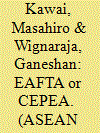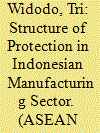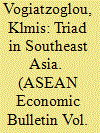| Srl | Item |
| 1 |
ID:
083672


|
|
|
|
|
| Publication |
2008.
|
| Summary/Abstract |
The spread of free trade agreements (FTAs) in East Asia amidst slow progress in the WTO Doha negotiations has stimulated a debate over the way forward. This paper examines the region's evolving trade architecture, characteristics of FTAs and welfare implications of alternative FTA scenarios. It suggests that consolidation of multiple and overlapping FTAs into a single East Asian FTA can help mitigate the harmful noodle bowl effects of different tariffs, rules of origin and standards. The paper also suggests that WTO-plus elements need to be further expanded and that consolidation into a Comprehensive Economic Partnership in East Asia at the ASEAN+6 level would yield the largest gains to East Asia among plausible regional trade agreements. As the next priority, the paper points to the formation of FTAs between East Asia, the United States and the EU as well as making FTAs more multilateral-friendly.
|
|
|
|
|
|
|
|
|
|
|
|
|
|
|
|
| 2 |
ID:
083674


|
|
|
|
|
| Publication |
2008.
|
| Summary/Abstract |
This paper aims to analyse structure of protections in Indonesian manufacturing sector. Firstly, it describes the evolution of Indonesian industrial and trade policies. To some extent, Indonesian industrial and trade policies follow a statement of the supporters of liberalization: "good times mean bad policies and bad times mean good policies". Secondly, effective rate of protection analysis shows that Indonesian manufacturing sector has been liberalized more, especially after the 1997 economic crisis. The liberalization in manufacturing sector has also been encouraged by international/regional commitments such as the WTO, IMF, ASEAN Free Trade Agreement and other preferential trade agreements. Thirdly, Indonesian trade liberalization in the manufacturing sector was faster than that of Thailand and could catch up with Malaysian trade liberalization
|
|
|
|
|
|
|
|
|
|
|
|
|
|
|
|
| 3 |
ID:
083673


|
|
|
|
|
| Publication |
2008.
|
| Summary/Abstract |
By estimating three panel data models, the paper examines empirically the determinants of outward FDI of each Triad economy within the AFTA regional integration area over the 1995-2004 period. From the AFTA members' perspective, our econometric analysis provides information on the deterministic factors of inward FDI within AFTA originating from the United States, EU, and Japan. Our findings indicate that the FDI determinants and their relative importance differ to a considerable extent across the Triad. In general, however, international integration-related factors (such as the host country's degree of openness to the international economy and the importance of bilateral trade relations between the home and host country) as well as market-related factors (such as the host country's market size and the host country's degree of intra-AFTA market accessibility) are found to be the most important location determinants.
|
|
|
|
|
|
|
|
|
|
|
|
|
|
|
|